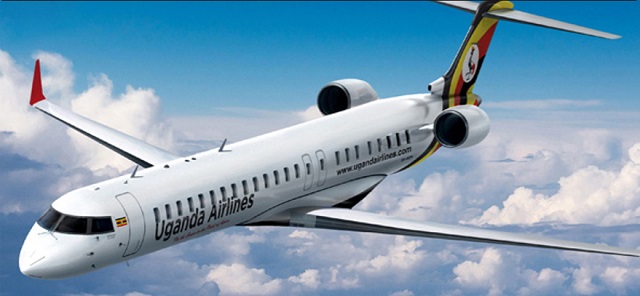
Analysts say carrier will struggle to compete at fair rates and service
Kampala, Ugannda | THE INDEPENDENT | Uganda’s national flag carrier, Uganda Airlines, has again announced that it will commence commercial flights at the end of this month.
The airline officials say the carrier received an operating licence, commonly known as Air Operator Certificate (AOC), from the Civil Aviation Authority on July 26 and it is ready to fly although it was scheduled to start commercial flights in July.
Jennifer Bamuturaki, the Commercial Director, Uganda Airlines confirmed that the carrier is now looking at commencing commercial flights on Aug. 28, using the recently acquired two CRJ aircraft with a sitting capacity of 76 passengers.
“Now that we have received the AOC…we are starting another process with the International Air Transport Association (IATA) to operationalise our two letter code that has been on the test mode, with all our reservations and accounting systems,” she said. “Once that is done, then, we will start our normal advertising (for flight bookings).
IATA is the industry association for international airlines. It has a membership of 290 airlines, and is charged with global commercial standards for the air transport industry.
Bamuturaki said the carrier will in the first phase start with flights to Nairobi, Dar es Salaam, Mogadishu, Kilimanjaro, Mombasa, Bujumbura and Juba.
The airline will add more destinations including Kigali, Goma, Lusaka, Johannesburg, Harare and Bangui in the second phase following delivery of the third and fourth CRJ aircraft later in the year.
Uganda Airlines also plans to fly the A330-800neos from the French aeronautics manufacturer, Airbus, for long-haul flights. These include; London, Bangkok, Guangzhou, Dubai, Tel Aviv and New Delhi. It is still not clear when Uganda Airlines will commence flights to these destinations.
But as plans to return Uganda Airlines to the air continue apace, some analysts remain sceptical about whether this is the right time to get back into business. This comes at a time the aviation industry has become so competitive and most national carriers have to rely on their governments to fund operations.
These, among others include; Kenya Airways, RwandAir, South African Airways, Air Zimbabwe, Air Namibia, Air Botswana and Air India.
Uganda’s plan to revive the national carrier gained momentum on Dec. 31, 2016, when President Yoweri Museveni said in his New Year message that the government had finalized plans to revive the carrier in a bid to ease travel in and out of the country and reduce the local travelers’ expenditure on foreign airlines estimated to be around US$420 million per annum.
Started nearly four decades ago, Uganda Airlines was liquidated by Museveni’s government in 2001 due to mismanagement and accumulated debt.
Lessons Uganda Airlines can learn from Ethiopian Airlines
Hire professionals
Experts in matters aviation say an airline eyeing to make profits need to hire professionals, and not politicians. They cite, for instance, the current Ethiopian Airlines CEO Tewolde Gebremariam, who began working for the Airlines’ cargo traffic handling department in 1985 and worked his way up the ladder gradually.
No complementary tickets
There should be no complementary tickets to civil servants just like it is with the Ethiopian Airlines. This is in stark contrast with the South African Airlines where politicians get free air tickets even after they have left the civil service. Similarly, there is need to hire the standard number of staff needed on any flight and not merely creating jobs to the many people.
No reliance on government loans
For an airline to operate profitably, the government needs to make up its mind if it is merely a strategic asset or simply doing business. Airlines such as Kenya Airways, South African Airways always anticipate government loans in their operations. This is not the case with Ethiopian Airlines.
Seek for infrastructure and skills in-house
Ethiopian Airlines has Africa’s largest aviation training academy. It trains over 4,000 pilots, marketers and flight-attendants annually.It also owns the largest cargo terminal in Africa, the largest technical maintenance facility, and plans to expand its catering facility to 80,000 meals per day, again making it the largest in Africa. The airline set itself a target of flying to 90 destinations by 2025 globally, but Gebremariam announced recently that they already serve 100 destinations.
****
 The Independent Uganda: You get the Truth we Pay the Price
The Independent Uganda: You get the Truth we Pay the Price



i want to make a comment about uganda Airlines but you have a faulty security system which is not allowing for comments to be posted. It claims something about a patch vulnerabilty
THE LINK TO FACEBOOK LINK FOR THE FULL ARTICLE OF WHY THERE ARE 9 REASONS FOR UGANDA AIRLINES DOOM TO FAILURE https://www.facebook.com/mary.mugisha.1/posts/1658561087607253
9 REASONS WHY THE REVIVED UGANDA AIRLINES WILL FAIL.
A report from an insider whistle blower
1. Dubious facts of who truly are the owners of Uganda Airlines. Publicly it is claimed that Uganda Airlines is co-owned by the Uganda Ministry of Finance in conjunction with the Uganda Ministry of works. However many of us insiders within Uganda Airlines doubt the validity of this claim and have forever questioned why Export Development Canada (EDC) had pulled out from financing the purchase of Uganda Airlines fleet from Canada’s Bombardier Aircraft Manufacturers. Reasons put forward by Aviation experts and Uganda Airlines insiders point to the feasibility study for the business viability of Uganda Airlines that was littered with facts doctored through personnel from Uganda Bureau of statistics so as to influence and justify the revival of the Airline. (In this feasibility study it had projected that Uganda Airlines would start making profits after two years of operation. Now that projection has recently been contradicted when Cornwall Muleya the technical advisor to Uganda Airlines presented to the Uganda Parliament that it would be 9 years before profits are seen. Even the total operations costs presented by Muleya was not the same as in the feasibility study) Another Possible reason for EDC’s pulling out could have involved the confusing true ownership of Uganda Airlines which had discrepancy with the dates of register and the variant names for the registration of the company with the Uganda Registry Bureau Service. In which Uganda Airlines parent company is known as ‘Uganda National Airline Company Ltd’ and its association with another company known as ‘Uganda Airlines Holdings Ltd’ as well as pre registration names with a similar company known as ‘Uganda National Airlines Ltd’ which is now operating under the name ‘Ugand Airlines’ instead of the publicly known national carrier name of ‘Uganda Airlines’. Email Queries sent to EDC by some insiders like me on why they pulled out from Financing Uganda Airlines was re-directed to the Canada Ministry of Foreign Affairs whom also declined to speak on the matter. Following EDC’s pull out, a Ugandan delegation headed by the Ugandan President’s brother in law, Sam Kutesa (also Uganda’s Minister of foreign Affairs with a reputation as a crooked investor and owner of multiple businesses in the Uganda aviation industry) flew to India, China and Qatar to seek financing for the jets. It is not however clear who has truly ended up financing Uganda Airlines, but publicly it is claimed that the Uganda Government is the financier after Uganda Parliament in late July of 2019 sought to approve a supposedly 586Bn UGX supplemental budget for Uganda Airlines. It is also common Insider knowledge that the Ministry of works under the weak and useless Minister Azuba Ntege, has no influence at all on Uganda Airlines matters other than by the ministerial docket where the company falls under Uganda Civil Aviation hence the Ministry of works. The actual bodies wielding power over Uganda Airlines are elements within the Ministry of Finance and State House of Uganda.